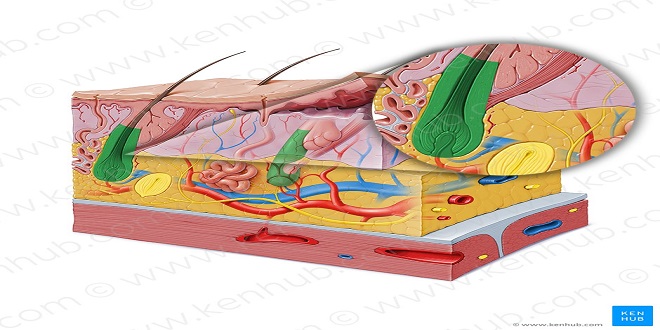The Integumentary System: Your Skin, Hair, Nails, and Glands

The skin
The two major layers of the skin are the outer epidermis and the inner dermis. Each of these layers is made of different tissues and has very different functions.
Epidermis
The epidermis is made of stratified squamous keratinizing epithelial tissue and is the thickest on the palms and soles. The cells that are most abundant are called keratinocytes, and there are no capillaries present between them. Although the epidermis may be further subdivided into four or five sublayers, two of these are of greatest importance: the innermost layer, the stratum germinativum, and the outermost layer, the stratum corneum
Stratum germinativum
The stratum germinativum may also be called the stratum basale. Each name tells us something about this layer. To germinate means “to sprout” or “to grow.” Basal means the “base” or “lowest part.” The stratum germinativum is the base of the epidermis, the innermost layer in which mitosis takes place. New cells are continually being produced, pushing the older cells toward the skin surface. These cells produce the protein keratin, and as they get farther away from the capillaries in the dermis, they die.
Stratum Corneum
The stratum cornea, the outermost epidermal layer, consists of many layers of dead cells; all that is left is their keratin. The protein keratin is relatively waterproof, and though the stratum corneum should not be thought of as a plastic bag encasing the body, it does prevent most evaporation of body water. Also of importance, keratin prevents the entry of water. Without a waterproof stratum corneum, it would be impossible to swim in a pool or even take a shower without damaging our cells.
Read More: themakernewsz.com
Langerhans Cells
Within the epidermis are Langerhans cells, which are also called dendritic cells because of their branched appearance when they move? These cells originate in the red bone marrow, and are quite mobile. They are able to phagocytize foreign material, such as bacteria that enter the body through breaks in the skin. With such ingested pathogens, the Langerhans cells migrate to lymph nodes and present the pathogen to lymphocytes, a type of white blood cell.
Hair Follicles
Hair follicles are made of epidermal tissue, and the growth process of hair is very similar to growth of the epidermis. At the base of a follicle is the hair root, which contains cells called the matrix, where mitosis takes place? The new cells produce keratin, get their color from melanin, then die and become incorporated into the hair shaft, which is pushed toward the surface of the skin. The hair that we comb and brush every day consists of dead, keratinized cells.
Nail Follicles
Found on the ends of fingers and toes, nail follicles produce nails just as hair follicles produce hair. Mitosis takes place in the nail root at the base of the nail, and the new cells produce keratin (a stronger form of this protein than is found in hair) and then die. Although the nail itself consists of keratinized dead cells, the flat nail bed is living epidermis and dermis. This is why cutting a nail too short can be quite painful.
Glands
Glands are made of epithelial tissue. The exocrine glands of the skin have their secretory portions in the dermis. Sebaceous Glands. The ducts of sebaceous glands open into hair follicles or directly to the skin surface. Their secretion is sebum, a lipid substance that we commonly refer to as oil. As mentioned previously, sebum inhibits the growth of bacteria on the skin surface.
Blood Vessels
Besides the capillaries in the dermis, the other blood vessels of great importance are the arterioles. Arterioles are small arteries, and the smooth muscle in their walls permits them to constrict (close) or dilate (open). This is important in the maintenance of body temperature, because blood carries heat, which is a form of energy.
SUMMARY
The integumentary system is the outermost organ system of the body. You have probably noticed that many of its functions are related to this location. The skin protects the body against pathogens and chemicals, minimizes loss or entry of water, blocks the harmful effects of sunlight, and produces vitamin D. Sensory receptors in the skin provide information about the external environment, and the skin helps regulate body temperature in response to environmental changes.





